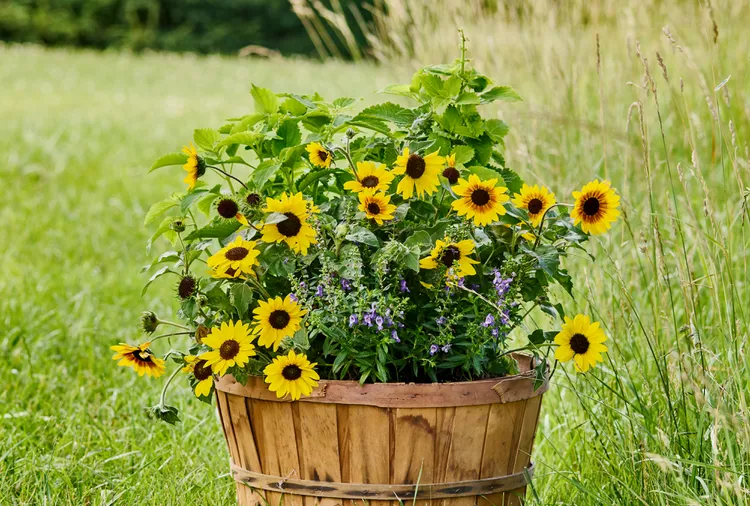A beloved summer annual, sunflowers make a statement in the garden with their brightly colored petals. Growing sunflowers in pots allows you to enjoy these vibrant, beautiful flowers in any sunny spot, whether you have a spacious yard or only have a small porch or balcony. It's also a fun way to play with different varieties of sunflowers, from the classic bright yellow types to orange and red ones. This guide to growing sunflowers in pots provides planting instructions, plus tips on watering, fertilizing, and staking your plants.
Steps for Planting Sunflowers in Pots
1. Select a large pot.
Choosing the right-sized container is key to growing sunflowers in pots. Most varieties of sunflowers grow several feet tall, sometimes reaching five to six feet. When growing sunflowers in pots, make sure the container has plenty of depth and space to support the roots. Sunflowers have tap roots that need room to extend fully. Choose containers with enough depth that they can hold at least two feet of soil so the roots have ample room to grow.
Dwarf sunflower varieties work well in containers because they stay shorter.
2. Use enriched potting mix.
Sunflowers aren't too picky about the soil they grow in, as long as it's well-drained. In a container, it's best to use a commercial potting mix to ensure good drainage. And because sunflowers are heavy feeders, which means they need a lot of nutrients from the soil, it's a good idea to amend the potting mix with some compost or aged manure to ensure your plants thrive.
3. Sow sunflower seeds in warm weather.
The best time to sow sunflower seeds is after the last frost has occurred in spring and when soil temperatures are around 50°F. Growing sunflowers in pots means you don't have to rely on the outdoor soil temperature, but it's a good indicator that the weather is warming up and it's time to grow these flowers.
Choose high-quality seeds to ensure optimal germination. Sow seeds directly into the container you want your sunflowers to grow in. The reason is simple: sunflowers don't like to be moved or uprooted. Sow seeds 1- 1 ½ inches deep and space them around 6 inches apart.
Consider sowing sunflower seeds over a month or so to enjoy blooming times for a longer period.
Watering and Fertilizing Sunflowers in Pots
After sowing the seeds, water them each day to keep the soil moist. Make sure the soil stays moist but not soggy while your sunflower seedlings are developing. Once your sunflowers are well-established in the pot, it's best to water them deeply and less frequently instead of watering a little more often. Typically, this means watering sunflowers once a week, and providing enough water at a time that it drains out the bottom of the pot. Check the soil moisture level by placing your finger into the soil a couple of inches deep. If it's dry, water your sunflowers.
Fertilize sunflowers in pots about once a month, using an all-purpose liquid fertilizer at half strength of what the label directions call for.
Sunlight and Temperature Requirements
Sunflowers are sun-loving annual flowers so place your containers in a spot that receives direct sunlight at least 6-8 hours a day. They do best in warm weather, so may be slower to grow if you plant them too soon in spring before temperatures stay above 50°F.
Supporting and Staking Sunflowers
When growing sunflowers in pots, you may need to stake them or use a trellis to keep them from falling over as they grow tall. Many varieties don't need to be staked but there are some situations when extra support may be beneficial. If you're growing sunflowers in a windy area and there isn't a way to protect them, staking them can help them stay upright through blustery weather. Another reason to give your sunflowers extra support is if they aren't getting sufficient sunlight. This can result in weaker stems that need staking.
Use metal or wooden stakes and place them near the sunflower stem. Use twine or soft ties to wrap around the sunflower stalk and stake.
Pests and Problems
Once established, sunflowers aren't usually bothered by pests or diseases. Rabbits and deer may snack on the plants so if you live in an area with plenty of these animals around, you may need to place a wire fence with tiny holes around your pots. Or keep your sunflower containers close to your house where wildlife may be less likely to venture.
If potted sunflowers sit in too much water, they may develop root rot. This occurs because the roots aren't able to absorb sufficient oxygen (yes, roots need to breathe too). To avoid this problem, use a soil mix intended for containers, and if you have a saucer under the pot, make sure to empty it out rather that leave the pot sitting in it.




















